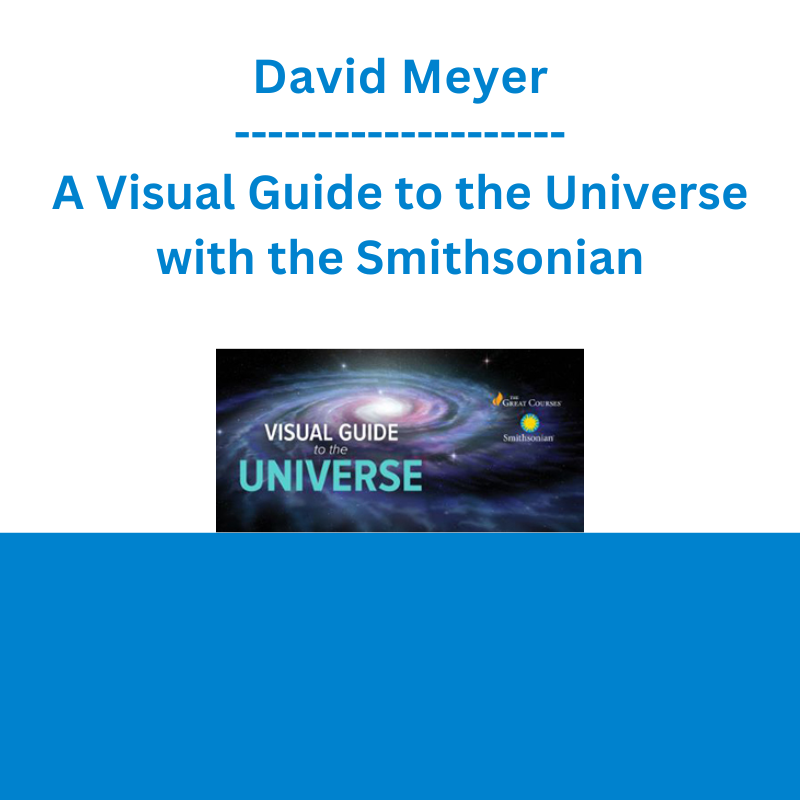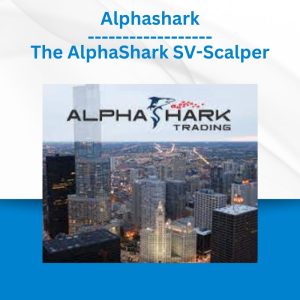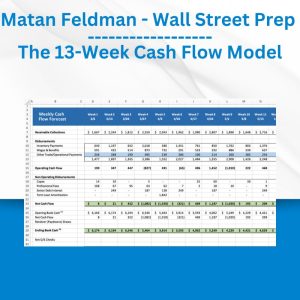*** Proof of Product ***
Exploring the Essential Features of “David Meyer – A Visual Guide to the Universe with the Smithsonian”
A Visual Guide to the Universe with the Smithsonian
Produced in partnership with the Smithsonian, these 18 lavishly illustrated lectures take you from our solar system to the farthest reaches of space and time.
LECTURE
Trailer
01:Probing the Cosmos from Space
Prepare for your cosmic journey by surveying NASA’s space exploration strategy. Although human spaceflight gets the lion’s share of publicity, the greatest scientific discoveries in space are the work of planetary probes and space observatories. Learn why this approach has paid off so spectacularly.
28 min
02:The Magnetic Beauty of the Active Sun
Explore the sun in astonishing detail through the multispectral instruments of the Solar Dynamics Observatory. See debris from magnetic storms explode into space and then crash back into the sun. Learn how these mammoth outbursts affect Earth.
28 min
03:Mars-Water and the Search for Life
Discover that Mars is a water world whose surface dried up long ago and may once have supported life. Four robotic rovers have landed on Mars, including the sophisticated Curiosity rover, now crawling across the planet searching for clues connected to microbial life forms.
29 min
04:Vesta and the Asteroid Belt
Study fossil remains of the early solar system, preserved in the rocky debris of the asteroid belt between Mars and Jupiter. Focus on one of the largest asteroids, Vesta, viewing it close up via the Dawn spacecraft. Learn how pieces of Vesta have fallen to Earth as meteorites.
29 min
05:Saturn-The Rings of Enchantment
Examine Saturn through the eyes of the Cassini probe, which has been orbiting the ringed planet since 2004, taking spectacular pictures of Saturn’s cloud tops, moons, and especially the enigmatic ring system. Examine competing theories for the origin of this complex circular band.
29 min
06:The Ice Moons Europa and Enceladus
Focus on two enigmatic ice worlds: Jupiter’s moon Europa and Saturn’s moon Enceladus. Both may harbor liquid water beneath their icy crusts. Weigh the chances that life exists in these underground oceans, despite the extreme cold in the outer solar system.
27 min
07:The Search for Other Earths
Join the Kepler telescope in the search for other Earths. Kepler has spotted thousands of candidate planets orbiting other stars, including many that are roughly Earth-sized. Learn how planets are detected at stellar distances, and study the conditions needed to support life.
31 min
08:The Swan Nebula
Venture into a nearby spiral arm of the Milky Way galaxy, as imaged in infrared light by the Spitzer Space Telescope. See how Spitzer’s panorama of the Swan nebula reveals that spiral arms are active regions of star formation, showing up brilliantly in the infrared band.
31 min
09:The Seven Sisters and Their Stardust Veil
The Pleiades cluster, or Seven Sisters, is one of the most beautiful star formations in the heavens. Discover the origin of the wispy nebulae that surround these bright stars. In the process, learn how the Hertzsprung-Russell diagram is a powerful tool for estimating the ages of star clusters.
30 min
10:Future Supernova, Eta Carinae
Explore the imminent fate of the luminous star Eta Carinae, a ticking bomb due to explode as a supernova in the next few hundred thousand years. Study the life cycle of stars, and trace the history of Eta Carinae to mysterious events first observed in 1843.
31 min
11:Runaway Star, Zeta Ophiuchi
Why is the enormous star Zeta Ophiuchi careening through our galaxy at unusually high speed? Probe the mystery of this runaway star and its gorgeous shock wave, using images from the Spitzer Space Telescope and other observatories to tell a story of massive interacting stars and a likely supernova explosion.
30 min
12:The Center of the Milky Way
Travel to the most exotic sector of the Milky Way, the galactic center, which has a black hole four million times more massive than the sun and is orbited by hot gas and giant stars. View this violent region at multiple wavelengths using the most advanced telescopes of our day.
31 min
13:The Andromeda Galaxy
Investigate the nearby Andromeda galaxy, tracing its puzzling spiral arms. Use images from the Galaxy Evolution Explorer and other telescopes to gather evidence that something once crashed into Andromeda. Then chart Andromeda’s collision course with our own galaxy!
30 min
14:Hubble’s Galaxy Zoo
Use the sharp eye of the Hubble Space Telescope to survey some of the most peculiar galaxies in the local universe. Focus on Hoag’s Object, a ring galaxy with a yellow nucleus, surrounded by a nearly perfect circle of hot blue stars. Explore competing ideas for the origin of this unique structure.
30 min
15:The Brightest Quasar
Travel to some of the most distant and luminous objects in the universe: quasars. Discovered in the early 1960s, these active galaxies are associated with matter-devouring supermassive black holes. Investigate the brightest and first-found quasar, called 3C 273, and learn what it reveals about the early universe.
30 min
16:The Dark Side of the Bullet Cluster
Investigate mounting evidence that invisible dark matter must exist. Then see how telescopes scanning the sky at different wavelengths have mapped the distribution of dark matter, notably in a collection of distant colliding galaxy clusters called the Bullet Cluster.
31 min
17:The Cosmic Reach of Gamma-Ray Bursts
Search for the origin of the most powerful explosions since the big bang. Known as gamma-ray bursts, these colossal beams of high-energy radiation are among our deepest views into the cosmic past. Also consider the chance that a nearby gamma-ray burst could cause a mass extinction on Earth.
30 min
18:The Afterglow of the Big Bang
Conclude your cosmic tour by probing the echo of creation: the faint afterglow of the big bang, which is present everywhere in space. View this signal in increasing detail provided by spacecraft, and uncover its astonishing story about the earliest epoch of our vast universe.
44 min
DETAILS
Overview
The spectacular sights of the cosmos are now as easy to see as the stars above, with the 18 lavishly illustrated lectures of A Visual Guide to the Universe, produced in partnership with the Smithsonian. Orbit Saturn, search for water and life on Mars, and witness an armada of space telescopes uncovering the secrets of the cosmos. Embark on great voyages of discovery-you’ll find the view is truly out of this world!
About
David M. Meyer
I have found no better way to communicate the joy of discovery in astronomy than through the beautiful cosmic images obtained by the Hubble Space Telescope.
Dr. David M. Meyer is Professor of Physics and Astronomy at Northwestern University, where he is also Director of the Dearborn Observatory and Co-Director of the Center for Interdisciplinary Exploration and Research in Astrophysics. He earned his B.S. in Astrophysics from the University of Wisconsin, and his M.A. and Ph.D. in Astronomy from the University of California, Los Angeles. He continued his studies as a Robert R. McCormick Postdoctoral Fellow at the University of Chicago’s Enrico Fermi Institute before joining the Northwestern faculty. Professor Meyer’s research focuses on the spectroscopic study of interstellar and extragalactic gas clouds-work carried out over the past 15 years with the help of the Hubble Space Telescope. Along with his collaborators, Professor Meyer has conducted 20 research projects with Hubble, resulting in 25 peer-reviewed publications. He has also served five times on the committee that annually selects the most deserving proposals for Hubble observing time. During his career at Northwestern, Professor Meyer has specialized in designing and teaching introductory undergraduate courses in astronomy, cosmology, and astro-biology for non-science majors. His many teaching awards include the Charles Deering McCormick Professorship of Teaching Excellence, Northwestern’s highest teaching honor. Beyond campus, Professor Meyer has delivered popular talks on Hubble to young and old in settings as far-flung as a transatlantic crossing.
REVIEWS
Dave63
Crystal clear explanations and awe-inspiring pictu
If ever there was a way of promoting The Great Courses series of lectures, then this is at the top to use. Riveting.
Please see the full list of alternative group-buy courses available here: https://lunacourse.com/shop/










 Sovereign Man Confidential - Renunciation Video
Sovereign Man Confidential - Renunciation Video  Erik Banks - Alternative Risk Transfer
Erik Banks - Alternative Risk Transfer  Emanuele Bonanni - My Trading Way
Emanuele Bonanni - My Trading Way  Matan Feldman - The 13-Week Cash Flow Modeling - Wall Street Prep
Matan Feldman - The 13-Week Cash Flow Modeling - Wall Street Prep  Money Miracle - George Angell - Use Other Peoples Money To Make You Rich
Money Miracle - George Angell - Use Other Peoples Money To Make You Rich  Simpler Trading - Bruce Marshall - The Options Defense Course
Simpler Trading - Bruce Marshall - The Options Defense Course  Team NFT Money - Ultimate NFT Playbook
Team NFT Money - Ultimate NFT Playbook  George Fontanills & Tom Gentile - Optionetics Wealth Without Worry Course
George Fontanills & Tom Gentile - Optionetics Wealth Without Worry Course  Forexmentor - Recurring Forex Patterns
Forexmentor - Recurring Forex Patterns  Toshko Raychev - Profit System + ITF Assistant
Toshko Raychev - Profit System + ITF Assistant  SMB - Options Training
SMB - Options Training  Julie Stoian & Cathy Olson - Launch Gorgeous - Funnel Gorgeous Bundle
Julie Stoian & Cathy Olson - Launch Gorgeous - Funnel Gorgeous Bundle  Crypto Dan - The Crypto Investing Blueprint To Financial Freedom By 2025
Crypto Dan - The Crypto Investing Blueprint To Financial Freedom By 2025  George Fontanills & Tom Gentile - Optionetics 6 DVD Series Home Study Course (Digital Download)
George Fontanills & Tom Gentile - Optionetics 6 DVD Series Home Study Course (Digital Download)  Greg Loehr - Advanced Option Trading With Broken Wing Butterflies
Greg Loehr - Advanced Option Trading With Broken Wing Butterflies  Go Java Full Stack - Spring Boot and Angular
Go Java Full Stack - Spring Boot and Angular  Ed Ponsi - Forex Trading
Ed Ponsi - Forex Trading